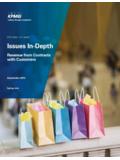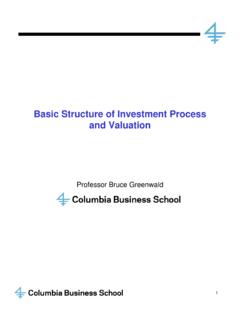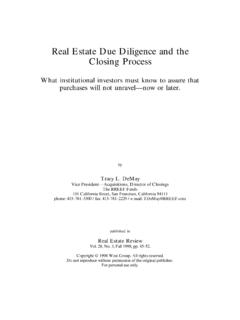Transcription of Better Understanding the Process through …
1 Department of Professional Practice Better Understanding the Process through flowcharting An Implementation Guide August 2014 Better Understanding the Process through flowcharting An implementation guide Preface A picture is worth a thousand words. The efficiency expert Edward Deming once said: Draw a flowchart for whatever you do. Until you do, you do not know what you are doing, you just have a job. Department of Professional Practice An Implementation Guide (the Guide) is designed to assist you in developing flowcharts as a tool to enhance your Understanding of the flow of information through your entity s processes and systems, the identification of likely sources of material misstatements in the financial statements and the controls in place to address those potential material misstatements.
2 The Guide is designed for use by management1 to help address the requirements, needs and objectives for evaluating and assessing an entity s internal control over financial reporting in accordance with Section 404 of the Sarbanes-Oxley Act of 2002 and the COSO 2013 Framework published by the Committee of Sponsoring Organizations of the Treadway Commission ( COSO ). This document is intended for informational and educational purposes and should not be used or relied upon to ensure an entity has met or will meet its responsibility with respect to internal control over financial reporting. Illustrations and guidance included within the Guide are designed to highlight key concepts and are not intended to be comprehensive examples of all elements that you should consider when obtaining an Understanding of the respective Process .
3 1 As this Guide has been designed for use by management, the use of terms such as you or your refer to employees or other individuals within the entity responsible for internal control over financial reporting. CONTENTS Background and objectives 2 Introduction to flowcharting 4 Basic flowcharting conventions 4 Standard symbols 5 Developing flowcharts 8 Leverage available information and validate management s Understanding 8 Identify the key steps and activities in the Process 8 Consider information systems 10 Challenge the flowchart 11 Potential questions to challenge the flowchart 11 Try not to.
4 12 Conclusion 13 Appendix Example Flow Chart 2 | Department of Professional Practice Implementation Guide Background and objectives Who should read this document? KPMG has prepared this document for management and members of corporate teams responsible for compliance with Sarbanes-Oxley Act Section 404 compliance (SOX 404) and COSO 2013. Why is it important? Management is responsible for maintaining a system of internal control over financial reporting2 (ICOFR) that provides reasonable assurance regarding the reliability of financial reporting and the preparation of its external financial statements.
5 This includes maintaining evidential matter, including documentation, to provide reasonable support for the assessment of the system. In its interpretive guidance, the SEC has noted that while the evaluation of ICOFR will vary from entity to entity, the top-down, risk-based typically be the most efficient and effective way to conduct the evaluation. This approach allows management to focus their attention and efforts on the risks that address the potential sources of material misstatement. flowcharting will assist management in accomplishing the above in the most effective and efficient manner. How can flowcharting help? To properly identify risks, management must obtain an Understanding of the flow of information through the financial reporting processes and IT systems.
6 Our experience has shown that a graphical depiction of the Process ( , a flowchart) provides the best means to demonstrate the flow of information through a Process and an IT system. It allows multiple parties to review the same information and understand the flow of information in basic terms from different perspectives within the organization ( Process owners, IT owners, etc.). It also allows for easier clarification of gaps in controls and risk areas (What Could Go Wrong s or WCGW) that have not been previously identified. Once management has gained an Understanding of the flow of information, it can identify the points in the Process at which a misstatement due to error or fraud could arise and would be material and the controls that have been implemented to address the potential misstatements.
7 Management can then select controls at that point or after that point in the flow to 2 As defined in Auditing Standard No. 5 An Audit of Internal Control Over Financial Reporting That Is Integrated with An Audit of Financial Statements. Department of Professional Practice Implementation Guide | 3 address the risks. We believe that flowcharts are an extremely useful tool to understand, confirm and document the flow of information. Why is flowcharting Better than a detailed narrative? The flow of information is easier to understand in a visual flowchart than in a long narrative. Flowcharts help: Depict the flow of transactions: how they are initiated, authorized, processed and recorded, including when information flows between multiple systems which is a common area where gaps are identified.
8 Identify the points within the entity s processes at which a misstatement including a misstatement due to fraud could arise, that individually or in combination with other misstatements could be material. Identify the controls, including automated and IT dependent application controls, that have been implemented to address these potential misstatements. Identify the controls that have been implemented over the prevention or timely detection of unauthorized acquisition, use or disposition of the entity s assets that could result in a material misstatement of the financial statements. Provide management with the requisite documentation to evidence their assessment of ICOFR.
9 Enable management to take a fresh look at the Process and controls in place, so that they can answer a number of questions, including: Do we have the most efficient control structure? Have we identified all the WCGWs? Are there points where automated controls would be more efficient and effective?;and Do our processes have redundant controls, and conversely, do we have all the WCGWs covered? Won t flowcharting our processes take time and energy? Converting narratives to flowcharts may take some initial investment. Our experience has shown that many existing Company narratives have some level of deferred maintenance as processes change throughout the years but the narratives haven t been updated timely.
10 Instituting a flowcharting Process to (i) reconfirm the Understanding of the Process , (ii) reconsider the appropriateness of the controls in place, and (iii) satisfy management s responsibility to perform risk assessment and fulfill their COSO documentation requirements will create a more effective program and create efficiencies down the road. Once in place, a flowchart can more easily be adapted as processes evolve. Moreover, flowcharting will reduce risk, facilitate a smoother audit and promote a clearer vision of processes and controls. In addition to helping identify missing controls, flowcharts can also help identify redundant controls, and help guide Process improvements.






